How an intern student created the world's most popular video game, or the history of Windows games
- Transfer
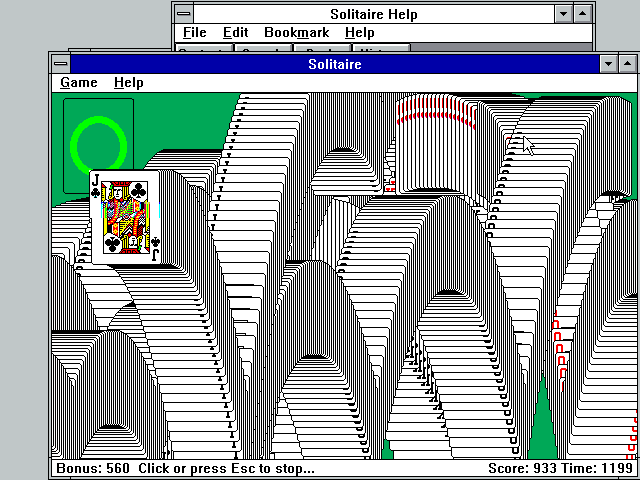
Two games can be told about games for Microsoft Windows that existed during the first ten years of this operating system’s presence on the market. One of them is extremely short, the other is slightly longer and much more interesting. We will start with the first.
During the first half of the decade mentioned (the era of Windows 1 and 2 ), major game publishers, like most other software developers, did not take the Microsoft GUI seriously. And why should they take him seriously? Very few used this GUI.
But even when Windows 3.0 came on the scene in 1990 and the creators of all kinds of software started to master it, the game publishers still turned up their nose on the GUI. The Windows API has greatly simplified the life of the creators of word processors, spreadsheets and databases, allowing them to create attractive applications with a standardized look and feel. But it seems to have been developed completely without taking into account the games; they were so low on Microsoft's list of priorities, as if they didn't exist at all. In fact, games are the kind of software for which there is nothing good about standardization; players need variety. The programmer could not even force the game for Windows to turn on full screen, it always remained limited to the edges of the window. No need to say how it interfered with immersion. Yes, indeed, the Windows library for programming graphics called Graphics Device Interface (GDI) freed programmers from the tyranny of hardware — they no longer needed to write separate modules to correctly interact with each video standard in the MS-DOS ecosystem well-known for its diversity. However, GDI was unfortunately slow ; for business graphics this is normal, but not suitable for most popular game genres.
For all these reasons, game developers, the only ones among the software makers in the early 1990s, stubbornly clung to MS-DOS, despite the fact that all other software had steadily shifted to Windows. It was only after the completion of the first decade of Windows that game developers finally recognized it. The gingerbread helped them in this (Microsoft still began to pay serious attention to their needs) and the whip (the ever-increasing variety of equipment on the market no longer allowed working with bare “hardware” in the MS-DOS style).
This is where the first story ends.
The second, more interesting history of games under Windows concerns those kindsgames that were very different products sold to gamers by publishers of traditional video games. People who played games of this type did not even think of calling themselves “gamers”; moreover, such a nickname would seem offensive to them. Nevertheless, every year they spent millions and millions of hours on the games, but not in the strange-smelling teen bedrooms, but in sterile-clean adult offices. But be that as it may, they still played games. In fact, they played so that Windows, which was recognized unfriendly to OS games, became probably the most successful gaming platform of the early 1990s, if we consider the number of man-hours spent on games. At the same time, hardcore players hardly noticed the most powerful democratization movement of computer games in the world.
Microsoft Windows, as well as its source of inspiration (Apple Macintosh), used the concept known as the “skeuomorphic interface”. This interface, built on analogues of real-world objects — paper documents, a desktop, and a trash can, was needed to show people who felt uncomfortable one-on-one with the flickering text-mode cursor, the more friendly face of computer technology. Therefore, it is not surprising that most of the early games under Windows were skeuomorphic too: they were soothingly old-fashioned versions of card and board games. Therefore, they turned out to be a kind of return to the origins of personal computing systems when hobby programmers shared with each other written versions of classic games written on BASIC. Thanks to the simple design, such games were placed in the tiny memory of the first microcomputers. It seemed that in Windows the old became new again - computer games started their way anew to capture a completely new audience.
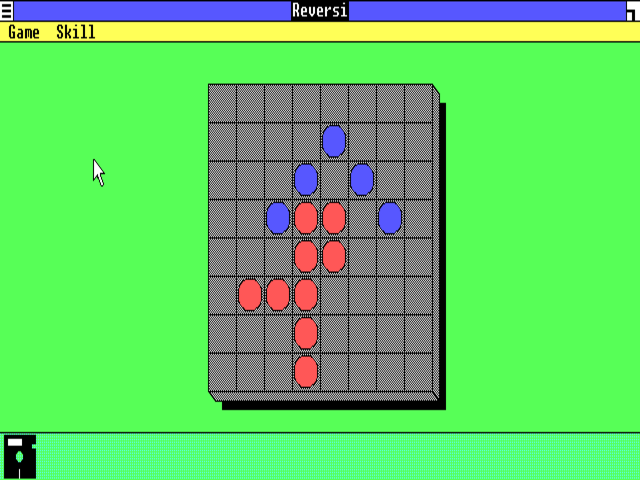
The very first game programmed to work under Windows naturally resembled a prototype. When Tandy Truwehr was presented with a heterogeneous and intricate Windows project in January 1985, he discovered that there were a handful of ready-made applets that, strictly speaking, were not part of the operating environment itself. It included a calculator, a rudimentary text editor and a computer version of the board game called Reversi.
Reversi is an abstract two-player game that looks like checkers and plays like a faster and simpler version of Japanese go. Its origin is not clear, but for the first time it gained popularity as a commercial product in late Victorian England. In 1971, an enterprising Japanese businessman made a couple of minor changes to the rules of the public domain game, patented the result, and began selling it under the name Othello. Under this name, she enjoys moderate popularity around the world today. In addition, under both her names, she became the darling of the first personal computers: simple rules and a rather limited space of possibilities fitted well into the limitations of programming on a BASIC computer with 16 KB of memory. In the October 1977 issue, Byte magazine (the bible of the first hackers of microcomputers) published the listing of the Othello program .
In 1984, one developer from the Windows team named Chris Peters decided to write a new version of the game under his own original (and not protected trademark) name Reversi. He basically did this to confirm the possibility of creating applications for Windows. Then tandy truvercontributed to the fact that part of the experimental applets of his team , including Reversi, were included in the first release of Windows in November 1985:
When the release of Macintosh was announced, I noticed that along with the computer, Apple was going to sell a small set of applications, among which was a small word processor called MacWrite and a drawing application MacPaint. In addition, Lotus and Borland had recently released DOS products under the names Metro and SideKick, consisting of a small set of console applications that could be opened using hotkeys while other applications were running. These packages included a simple text editor, a calculator, a calendar and a small database. So I turned to Bill Gates with Steve Ballmer, recommending adding a similar set of applications to the Windows bundle. To do this, it was necessary to improve several programs already in development, and also to add a few
Interestingly, the set of applets for MacOS did not include any games, except for a minimalist puzzle with moving numbers that occupied only 600 bytes. Apple II computers were bought more for schools and at home than for offices, and therefore the conservative business environment treated them with disdain. Because of this, Apple has sought to rid its new computer of any associations with games. But Microsoft, with its MS-DOS , on which all of corporate America worked, could afford a little frivolity.
However, as a result, Windows Reversi impressed almost no one. Reversi itself was generally more suited to hackers than to a wider audience; it lacked attractiveness, because very few people were familiar with the concept of the game. The implementation of Reversi was high quality, but no more. In addition, Windows 1 was purchased by very few people.
For a long time after that, Microsoft did not consider it necessary to develop new games for Windows. Reversi almost without changes migrated to a more successful Windows 2 and should have been saved in Windows 3.0. In addition, Microsoft did not have serious plans for games in Windows. But then, in one of the strangest episodes in the entire history of video games, companies donated software, which was intended to become the most popular game in terms of man-hours of all time: Windows Solitaire (Solitaire or Solitaire).

The idea of a single-player card game, ideal for killing time on long journeys in a horse-drawn carriage or in a train carriage, first spread throughout Europe and then around the world in the nineteenth century. Solitaire or Solitaire, as it is best known in Britain, is actually a collection of several different games that use a deck of ordinary playing cards. Also, Klondike (“Solitaire”) is the most popular type of solitaire.
Klondike Solitaire, like many other options, had many qualities that made it attractive for computer adaptation to a platform that greatly limits the programmer’s ambitions. The game of solitaire is more like a puzzle than a real game, but in this context it’s even good: what it istruly single-user, allows the programmer to not worry at all about artificial intelligence. In addition, its rules are simple, and game cards are easy to draw, even with the most primitive computer graphics. Therefore, it is not surprising that solitaire has become another favorite of game developers for the first microcomputers.
For these reasons, a student at the University of Cherry, who worked as a Microsoft intern in the summer of 1988, decided to create a version of Klondike solitaire similar to the one he played a lot on the Macintosh. (Yes, even when it comes to games written by Microsoft interns, Windows cannot escape the shadow of the Macintosh.) According to Cherry himself, there was “nothing outstanding” in the code of the game he wrote; she was neither better nor worse than thousands of other computer solitaires. In the end, how can you create a unique solitaire? It either works or not. Fortunately, he worked for Cherry, and was even complemented by a set of cute card shirts, painted by his girlfriend Leslie Coy. When asked about the most difficult aspect of writing a game, Cherry said that it was soon a significant cascade of cards after a victory: “I had to use all sorts of tricks to make this final cascade as fast as possible.” (Here is a good example of why most game programmers treated Windows with such disdain) At the end of the summer internship, he put solitaire on the server, where there were a lot of games and other small experiments,

A few months later, some unknown Microsoft manager was browsing the contents of the same server and discovered Cherry Solitaire. It seems that Microsoft belatedly began to look for a new, more interesting game than Reversi, to include it in Windows 3.0, which the company wanted to advertise to such serious consumers as businessmen. Now management has decided that this game should be solitaire. Therefore, they conducted a test and pulled Cherry out of his dormitory so that he would correct the errors found in exchange for a new computer. Meanwhile, Susan Ker, the famous MacOS look designer who now worked at Microsoft, slightly refined Leslie Coy's card shirts.
Therefore, at the time of the release of Windows 3.0 in May 1990, Solitaire was supplied with it. According to Microsoft, the game was designed to teach people how to use the GUI in a playful way, but this explanation always seemed dubious. The fact was that the computing market was changing, machines were again appearing in large numbers in homes, and adding a fun game to a serious operating system no longer seemed like a stigma. And a huge number of people will really start to consider Solitaire more than worthy entertainment.
The coverage that Windows Solitaire acquired over time, and to a large extent it still remains, is difficult to overestimate. (In 2006, the game was completely rewritten for Windows Vista. Presumably, the last remaining traces of the Cherry Weights source code disappeared from the program by that time. Since Windows 8 released in 2012, Klondike Solitaire is no longer part of the Windows installation package - more than Twenty-year tradition was interrupted. Perhaps due to the protest of users, in the release of Windows 10 released in 2015, the Microsoft Solitaire Collection appeared with advertising support.) Microsoft itself soon called solitaire “the most used” Windows application, one left victory ayuschey such heavyweight competitors such as Word, Excel, Lotus 1-2-3 and WordPerfect. The game has become the main symbol of office life around the world, it is launched during breaks and downtime. It is always rolled up somewhere against the background, which discourages annoying middle managers. Article inThe Washington Post in 1994 half jokingly asked the question - would Windows Solitaire Solitaire be a seed that would lead to the collapse of American capitalism?
“Yes, that's right,” says Frank Burns, manager of the largest MetaNet regional bulletin board. “We are used to offices that monitor screens are turned away from the wall. Now it's the other way around, because employees don't want the boss to see them play solitaire. ” "This epidemic consumes entire companies," says Dennis Jay "Homer" Pyles, president of Able Bodied Computers from Pleins, Va. “I installed Warrenton Windows on the computers of the water treatment plant, and the client’s first words at the next meeting were“ I scored 2000 points in solitaire ”.”
A business class in airplanes does not resemble a meeting of the board of directors, but a hall of arcade machines. According to flight attendants, serious gray-haired people in serious gray suits take laptops filled with spreadsheets and play solitaire on them, trying to beat their record.
Some companies, such as Boeing, usually remove solitaire from a set of Windows when they buy it, and in some cases even require that Microsoft not provide them with an OS with a game. Even PC Magazine has banned games during business hours. “Our editor wanted to get rid of the spirit of the student dormitory in the offices of the publication. Advertisers, coming to the office, first of all saw how the entire research department was chopped into solitaire. They did not have the best impression, ”said staff editor Tin Aldano.
Since then, such articles continued to appear on the pages of business publications. For example, when in 2006, New York Mayor Michael Bloomberg fired an employee for playing solitaire in the workplace, this created a big wave in the press with positive and negative reviews. But the harsh measures were not in vain - to imagine a modern office without solitaire is as difficult as without Microsoft Office.
But it cannot be said that the phenomenon of solitaire is limited only by life in the office. My wife's parents, pensioners who have not played any other game in their lives, spend several hours a week on solitaire. A 2007 Finnish survey showed that this is a favorite game of 36 percent of women and 13 percent of men; no other game can approach these indicators. Solitaire is infinitely attractive for a certain type of people, even more so than another proto-casual game of the early 1990s - Tetris . But why did this happen?
To begin to answer this question, we can refer to the pre-digital past of games. Collection of descriptions of the many versions of the solitaire "Solitaire game for one or several people"Whitmore Jones was first published in 1898. An amazing introduction to it, it largely foreshadowed modern discussions of Microsoft Solitaire and casual games in general.
In the old days, when the world was not yet living at the speeds of railways, playing solitaire was viewed rather contemptuously as a harmless but empty amusement of bored women. He was ironically called “the roundabout way of mixing cards,” but gradually he won a higher place for himself. Today, when the work and cares of life have so increased and multiplied, the activities that are interesting enough to absorb attention but do not require excessive brain strain, allowing the mind to relax in this way, are becoming more and more valuable.
In addition to illustrating the eternal complaints about the rhythm of modern life and nostalgia for the good old days as an integral part of the human soul, it also points to the main reason for the attractiveness of solitaire displayed on both real cards and the computer: it is a method of “absorbing attention without undue brain strain. ” This is an ideal game for killing time at the end of the working day, a respite between performing two different tasks or, as in the case of my wife's parents, a semi-active addition to watching TV programs.
Nevertheless, solitaire is not only a habitual occupation, even for those who have spent hundreds of hours on it; if that were the case, his appeal would be much less. In fact, he is not even completely honest. Approximately 20 percent of the layouts lead to a game that cannot be won - at least the original computer version of Cherry Weight does nothing to protect the player from the brutal mathematical reality. However, there is always the New Game menu option, a tempting chance to shuffle the cards and try your luck in a new combination. Therefore, although solitaire by its definition is of little interest to play, at the same time there is no end to it; somehow, the “New Game” option looks equally attractive when winning and losing. Attracted by familiar similarity with an analog card game,
As in the case of Tetris , one can argue here whether such a number of hours spent on a monotonous solitaire game is psychologically healthy behavior. Personally, I avoid her and her "time killers" just because such a waste of time later leads to dissatisfaction with herself. But there is another point of view, for example, a touching comment once left by a Reddit user to Weight of Cherry himself:
I just wanted to tell you that this is the only game I play. I have autism and I do not play games, because I cannot cope with the processing of sensory information, but Solitaire is “my” game.
I have his window open all day and every day. Monotonous cliques are very soothing. It helps me to relax and function as an ordinary person. The game greatly improved the quality of my life. I am very pleased with her existence. I never thought that I would find someone to thank for her, but perhaps I can say thank you. * hugs from a random internet stranger *
Cherry wrote Solitaire in Microsoft offices and during business hours, so the game was doomed to remain the company's intellectual property forever. He was never rewarded for creating the most popular computer game in history, except for a free computer. Wes says it suits him. He has long gone out of the computer industry, and now owns a clerk on Vashon Island in Puget Bay.
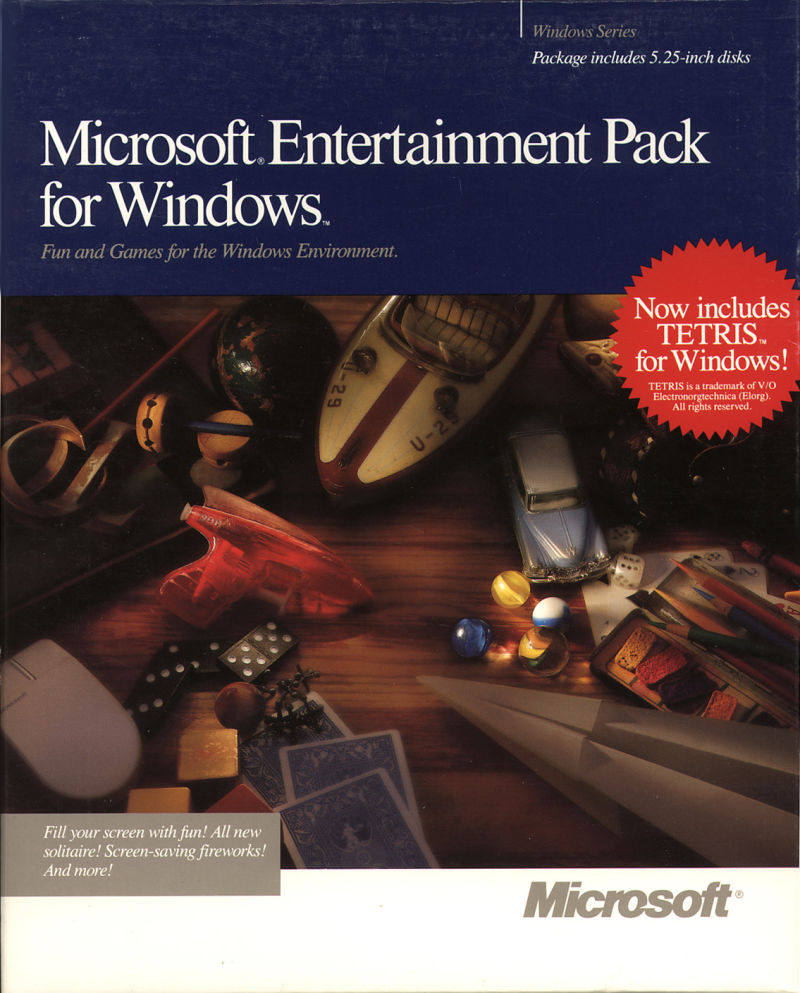
The popularity of Solitaire convinced Microsoft (if it had to be persuaded) that there was a place for such simple games (and perhaps a profitable place) in Windows. Between 1990 and 1992, the company released four Microsoft Entertainment Packs., each of which contained seven small games of varying degrees of fascination. Usually they were selected from projects written by programmers of the company in their free time. These games were the exact opposite of the games sold by traditional game publishers, who became increasingly ambitious, complicated the plot, and actively used video and sound recorded in the real world. Games from Microsoft carried the print of Solitaire Cherry: simple games, which demanded little from the players and from their computers. As conceived by Microsoft, they were intended for offices, which can be understood from the annotations on the boxes: “No more boring coffee breaks!”, “You no longer want to leave the office!”. Manager Bruce Ryan, who led the development of the Entertainment Pack, later described his target audience as "poorly controlled by business leaders."
The main hit of the first Entertainment Pack was the version of Tetris , which could be passed. It was created under license from Spectrum Holobyte, who owned the computer rights to the game. Cherry's weight, still working in his dorm room, created a clone of another old puzzle called Pipe Dream , which became the main core of the second Entertainment Pack; this time he was even compensated for the work, albeit rather modestly. As you can see from these examples, Entertainment Packs were not ambitious, they basically became high-quality copies of traditional games from the analog and digital world. Other games include solitaire variations, a clone of Activision Shanghai's hit mahjong., three-dimensional “tic-tac-toe”, a game of golf (in support of a cliché about serious businessmen) and even a version of John Horton Conway's famous work on the study of the cycles of cell life, better known as Life . (I wonder how bored office workers amused themselves in it ).
Venerable industry magazines like Computer Gaming World barely mentioned Entertainment Pack, but in two years more than half a million copies were sold, which was equal to or even surpassed the sales of the biggest hardcore hits of that era, such as the Wing Commander series. But even these impressive results do not fully reflect the popularity of time-killers developed by Microsoft. The lack of copy protection and compatibility with any Windows computer led to the stunning pirated distribution of Entertainment Packs: the games flew around the offices like hotcakes.
However, despite all the success, none of the Entertainment Pack games compare with the original Solitaire of Wes Cherry in the number of man-hours played. The most important reason for this is that Entertainment Packs were additions; To gain access to these games, player motivation and efforts were required, as well as a fairly accessible office environment in which one could bring his own software and install it on a working computer. Solitaire, on the other hand, was already bundled with every installed copy of Windows, unless system administrators were as smart and heartless as to find and remove it. The popularity of this archetypical game with a minimum of effort is ensured by the fact that no effort was required to launch it either. The user just ran across it while trying to figure out What is this new thing called Windows, which the office geek just installed on its old computer, or noticed the game from a colleague from the neighboring block. Five minutes later, the game captured him too.
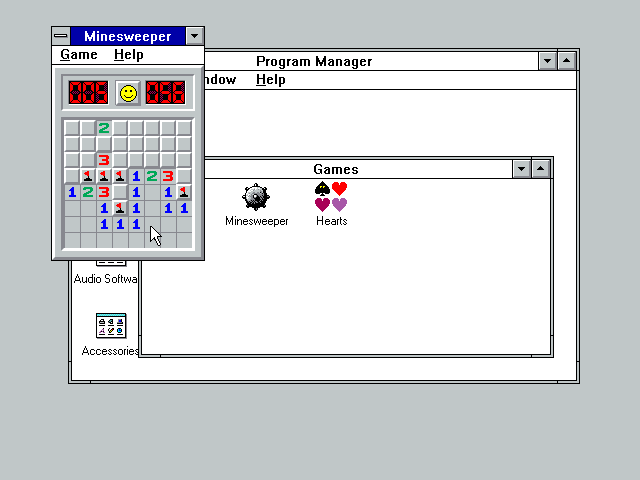
Therefore, the moment when Microsoft added in Windows 3.1 in 1992A new (or rather old) game has become a landmark. In fact, “Minesweeper” debuted as a game of one of the first Entertainment Pack, where he became a favorite for a sufficiently large number of players. Among them was none other than Bill Gates himself, who was so addicted to her that as a result he deleted it from his computer ... just to get a new dose of the game on his colleagues' machines. (This creates a most interesting field for fantasy. How would you react to the fact that your boss, who is also the richest person in the world, takes your computer to get into the Minesweeper?) Perhaps due to the patronage of the CEO of Minesweeper became in 1992, part of the standard Windows suite, replacing the hateful Reversi.
Unlike Solitaire and most Entertainment Pack games, Minesweeper was a personal creation, written in free time by staff programmers at the company, Robert Donner and Kurt Johnson. Nevertheless, she borrowed some of her ideas from the old board game “Sea Battle” , old computer games like Hunt the Wumpus, and especially from the computer game of 1985 called Relentless Logic. The player clicks on the grid squares to open their contents, which can be one of three: an empty cell, indicating that there are no mines in this or in the neighboring squares; a number indicating that this cell is empty. but the indicated number of neighbors contain mines; or a real mine (no luck!) that kills a player, instantly ending the game. Like Solitaire, Minesweeper combines a game and a puzzle, and both of its sides are not completely honest: although the program protects the player - the first selected cell never contains mines - you can get into a situation where you can only choose the next cell at random. But unlike Solitaire, Minesweeper has more of the pitfalls of video games we are used to, including a timer that motivates us to play quickly in order to score maximum points.
There is no doubt that it was precisely because of these signs of the video game “Minesweeper” never became the same office affiliation as Solitaire. However, those whom he delayed, found him even more interesting, not least because he demanded a greater level of involvement. "Minesweeper" also became a landmark part of life with Microsoft Windows and should be in the first places of any lists of the most frequently played games of all time. In addition, for office workers, he had one major advantage over Solitaire: Minesweeper ran in a small window, and therefore stood out less on the screen when the boss looked into the cubicle.
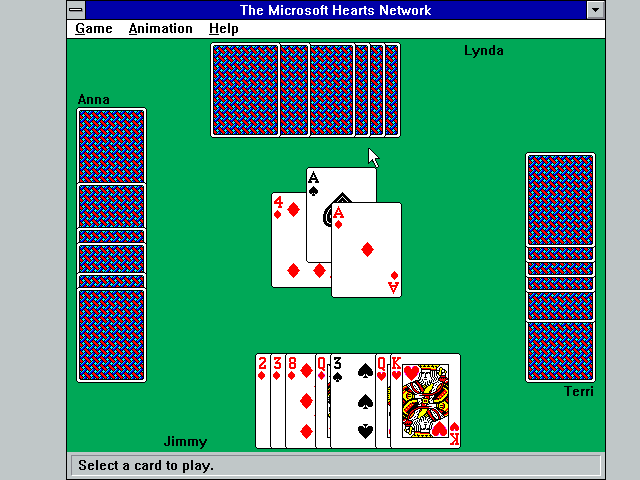
Microsoft added a third game to Windows for Workgroups 3.1, an option for a networked office environment. Staying true to its destination, Hearts (Hearts) was a version of an evergreen card game that could be played against computer opponents. But it was much more interesting when playing four real people at different computers. Its popularity was limited by the fact that the game was distributed only with Windows for Workgroups, but still it got its share of fame. By the standards of any ordinary computer game, “Hearts” were in fact quite popular for quite a long time and served many people as an introductory course on the concept of online games, which was to radically change the future of computer entertainment in the future. I remember many lively Hearts tournaments in the 1990s in my workplace. Human,
But whatever your favorite, Windows games have become an integral part of the process I've been documenting over the last couple of years: the process of expanding the audience of video game players. This was not achieved thanks to the fact that parents and office workers suddenly fell in love with the huge and long sci-fi or fantasy epics that most traditional computer games are still based on. No, everything turned out to be simpler - the games themselves came to their homes and offices. Instead of a fabulous five-course dinner, Microsoft offered them a game snack, suitable for busy work schedules and short pauses. None of the games described in the article has become an example of brilliant game design; their genius lies in the penetration of the player’s soul, which can even turn the game into an obsession. This entertainment, just becoming part of the software, which in the 1990s appeared on everyone’s computer, with the exception of a handful of loyal Macintosh followers, forced hundreds of millions of people to play computer games for the first time. The mainstream gaming revolution, which combines the gamification of basic daily activities, only began seriously with Microsoft Windows.
( Sources: Jesper Juul's book A Casual Revolution: Reinventing Video Games and Their Players ; Byte for October 1977; Computer Gaming World for September 1992; Washington Post of March 9, 1994; New York Times of February 10, 2006; online articles Technologizer , The Verge , B3TA , Reddit , Game Set Watch , Tech Radar , Business Insider, and Danny Glasser’s personal blog .)
